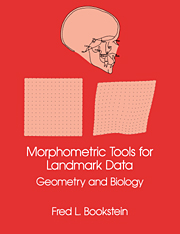5 - Shape coordinates
Published online by Cambridge University Press: 23 November 2009
Summary
The preceding chapter reviewed the statistical space of size measures appropriate to a data set of landmark locations. For modest sample ranges, the variability of a rich collection of alternative measurements – the distances between any pair of weighted averages of landmark locations, and all of their linear combinations – could be expressed by variations in a much simpler set of size measures, the distance between landmarks in pairs. But shape differences could be represented only very clumsily in such a system, by linear combinations of size variables emerging from path models explicitly incorporating a factor of log General Size. For data that are landmark configurations, there is a better approach to shape variation, still beginning with the space of distance measures, but working with ratios of distance measures instead of linear combinations. For triangles, we shall introduce specific pairs of variables, the shape coordinates, that span all the distance ratios, in fact, all the measurements of triangular shape that maintain the distinctions among the three vertices. (These coordinates have already been demonstrated in Chapter 1.) We shall postulate a simple and realistic null model for variation of these shape coordinates, the consequence of an assumption of unstructured noise in the locations of the landmarks separately. On this model, there is one single size variable that ought to underlie studies of allometry; it replaces the data-based first principal component used in the preceding section. The formalism of shape coordinates permits the computation of mean shapes for configurations of any number of landmarks and permits the testing of these configurations for group differences, correlations with exogenous covariates, size allometry, and the like, all in an unambiguous fashion, using familiar multivariate statistical methods. Reporting findings of this sort will be the concern of the following two chapters.
- Type
- Chapter
- Information
- Morphometric Tools for Landmark DataGeometry and Biology, pp. 125 - 186Publisher: Cambridge University PressPrint publication year: 1992



